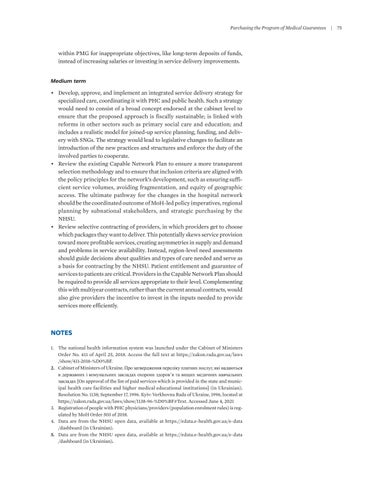Purchasing the Program of Medical Guarantees
within PMG for inappropriate objectives, like long-term deposits of funds, instead of increasing salaries or investing in service delivery improvements. Medium term
• Develop, approve, and implement an integrated service delivery strategy for specialized care, coordinating it with PHC and public health. Such a strategy would need to consist of a broad concept endorsed at the cabinet level to ensure that the proposed approach is fiscally sustainable; is linked with reforms in other sectors such as primary social care and education; and includes a realistic model for joined-up service planning, funding, and delivery with SNGs. The strategy would lead to legislative changes to facilitate an introduction of the new practices and structures and enforce the duty of the involved parties to cooperate. • Review the existing Capable Network Plan to ensure a more transparent selection methodology and to ensure that inclusion criteria are aligned with the policy principles for the network’s development, such as ensuring sufficient service volumes, avoiding fragmentation, and equity of geographic access. The ultimate pathway for the changes in the hospital network should be the coordinated outcome of MoH-led policy imperatives, regional planning by subnational stakeholders, and strategic purchasing by the NHSU. • Review selective contracting of providers, in which providers get to choose which packages they want to deliver. This potentially skews service provision toward more profitable services, creating asymmetries in supply and demand and problems in service availability. Instead, region-level need assessments should guide decisions about qualities and types of care needed and serve as a basis for contracting by the NHSU. Patient entitlement and guarantee of services to patients are critical. Providers in the Capable Network Plan should be required to provide all services appropriate to their level. Complementing this with multiyear contracts, rather than the current annual contracts, would also give providers the incentive to invest in the inputs needed to provide services more efficiently.
NOTES 1. The national health information system was launched under the Cabinet of Ministers Order No. 411 of April 25, 2018. Access the full text at https://zakon.rada.gov.ua/laws /show/411-2018-%D0%BF. 2. Cabinet of Ministers of Ukraine. Про затвердження переліку платних послуг, які надаються в державних і комунальних закладах охорони здоров’я та вищих медичних навчальних закладах [On approval of the list of paid services which is provided in the state and municipal health care facilities and higher medical educational institutions] (in Ukrainian). Resolution No. 1138; September 17, 1996. Kyiv: Verkhovna Rada of Ukraine, 1996, located at https://zakon.rada.gov.ua/laws/show/1138-96-%D0%BF#Text. Accessed June 4, 2021 3. Registration of people with PHC physicians/providers (population enrolment rules) is regulated by MoH Order 503 of 2018. 4. Data are from the NHSU open data, available at https://edata.e-health.gov.ua/e-data /dashboard (in Ukrainian). 5. Data are from the NHSU open data, available at https://edata.e-health.gov.ua/e-data /dashboard (in Ukrainian).
|
75

